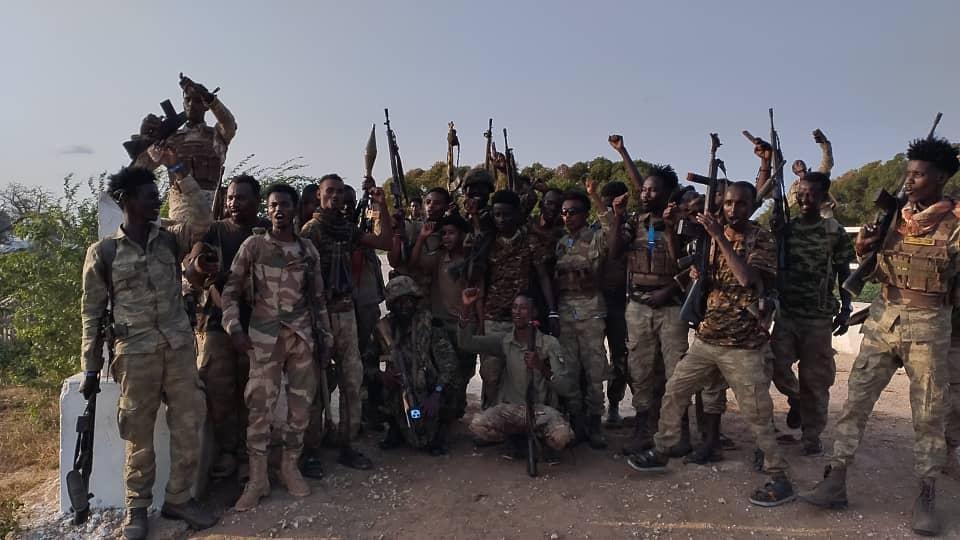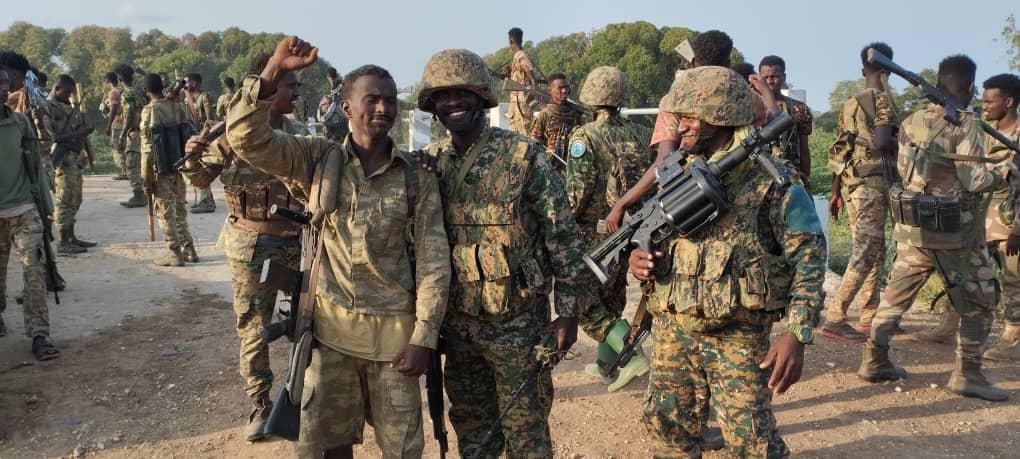By Faridah N Kulumba
Africa-Press – Uganda. At the beginning of August 2025, the Uganda Peoples’ Defence Forces (UPDF), operating under the African Union Support and Stabilisation Mission in Somalia (AUSSOM), in collaboration with the Somali National Armed Forces (SNAF), launched a major offensive to recapture Bariire town from Al-Shabaab militants.
This followed the al-Shaaab claims that it had overrun a Ugandan base and inflicted heavy casualties. UPDF refuted the claim by saying that the group often exaggerates battlefield gains in its propaganda, terming the claims as “psychological warfare.” In 2007 Uganda became part of the African Union Mission in Somalia (AMISOM) which ensured Somalia was liberated from al Shabaab Islamic insurgents. Uganda was the first country to send troops to Somalia and this opened the way for other African countries including Djibouti, Kenya, and Ethiopia to also deploy in the mission which was at one time dubbed as “dead on arrival” until UPDF’s arrival.
The operation
The attack was confirmed by the UPDF spokesperson Maj. Gen. Felix Kulayigye who said that the operation targeted Bariire – a strategic town situated approximately 50 kilometres south-west of the Somali capital, Mogadishu. The operation is part of “Operation Silent Storm,” a broader campaign to liberate key areas in Lower Shabelle region including Sabiid, Anole, Bariire, and Awdheegle. The UPDF also reported that fighting lasted for two days and that more than 50 Al-Shabaab fighters were killed including Mohammed Abdallah, an anti-tank specialist, Sadam Ibrahim, an improvised explosive device (IED) expert, and Abas, a senior infantry commander. Several other militants were wounded in the clashes, and operations are still underway to clear the remaining pockets of resistance. “This marks the second phase of Operation Silent Storm,” Maj. Gen. Kulayigye stated. “The towns of Sabiid and Anole have already been successfully recaptured. Fighting is ongoing in Bariire.”
Does Operation Silent Storm signal a turning point in the counterterrorism strategy in Somalia
In June this year the UPDF, the AUSSOM Troops in coordination with the SNAF, launched Operation dubbed as “SILENT STORM” against Al-Shabaab to recapture the previously lost Forward Operating Bases (FOBs) of Sabiid Anole, Aw Degeele and Bariire.

According to the UPDF, the operation resulted in the capture of scores of Al-Shabaab fighters along with their weapons including 12.7mm Anti-Aircraft Machine gun (AAMG) parts in the area of Sabiid Anole. The AUSSOM, UPDF and SNA forces are carrying out a sustained joint operation to dislodge the terrorists from Sabiid Anol, and was massively welcomed and supported by the locals. AUSSOM UPDF and SNA troops are highly commended for their bravery, coordination and dedication to securing Somalia. Their relentless efforts to degrade and eliminate Al-Shabaab’s presence are instrumental in ensuring peace, security, and stability in the region. The joint forces’ commitment to justice and their unwavering determination to protect the Somali people and the broader African community are truly commendable. Also in June, Ugandan troops serving with the AUSSOM and the SNAF recaptured strategic villages of Sabiid and Anole from Al Shabaab. This win came during a three-day joint operation code-named ‘Operation Silent Storm’, aimed at liberating areas under Al-Shabaab control in the Lower Shabelle region.
Strategic importance of Bariire town
Bariire town is located near Somalia’s capital city Mogadishu. Unfortunately the town is used as a key militant base for al-Shabaab. It has been a contested area due to its proximity to the capital and its use by militants for staging attacks and administering operations. Capturing Bariire is crucial for Somali government forces and their allies in their efforts to stabilize the Lower Shabelle region and secure Mogadishu due to several reasons including:
Strategic location- Bariire is located approximately 60 km west of Mogadishu, making it a convenient staging ground for attacks on the capital.
Control- For the al-Shabaab capturing Bariire means that the group al-Shabaab has control over critical infrastructure like bridges, disrupting the government’s supply lines and reinforcing the group’s regional dominance. The town’s location and control of vital routes and infrastructure have made it a crucial logistical hub for both sides of the conflict. Operation base- the town has been a site of intense military operations, with Somali and AU forces repeatedly battling to regain control. It has also been a key point in the drawdown of AU forces, with the handover of a Forward Operating Base (FOB) to the Somali National Army (SNA). Security- recapturing Bariire is seen as a critical step towards securing the Lower Shabelle region and disrupting al-Shabaab’s operations, contributing to overall stability in Somal
UPDF’s role in AUSSOM
Uganda’s army plays a big role in AUSSOM by contributing to peace and security efforts. Specifically. The UPDF is actively involved in offensive operations against al-Shabaab, securing key areas, and fostering civil-military cooperation to build trust with local populations. Recently, the UPDF, started coordinating with the SNAF, and launched operations to liberate towns and areas from al-Shabaab control. The UPDF is under AUSSOM Sector One, which is responsible for the Lower Shabelle region, a vital agricultural area and location of key infrastructure like the presidential palace and airport. Uganda’s army in AUSSOM also emphasizes civil-military cooperation (CIMIC) to build trust and positive relationships with the Somali population. The UPDF’s overall mission is to defend Uganda’s interests and contribute to a safe and secure environment for all Ugandans.
Who supports AUSSOM
The AUSSOM receives from the European Union (EU), the United States (US), and other international stakeholders in terms of financial, logistical, and political support. This support includes funding for military, police, and civilian components, as well as operational costs and Quick Impact Projects. The EU is a major contributor, having invested over €2.5 billion in AMISOM and continuing to support AUSSOM. The US has also been involved, though it has faced some disagreements with the AU over the funding model for the mission.
Kenya and Ethiopia’s position amid increased al-Shabaab activities

Kenya and Ethiopia are key players in the regional fight against al-Shabaab, with both nations facing significant threats from the terrorist group. Ethiopia, despite its own internal challenges, has deployed troops into Somalia, while Kenya has seen increased attacks along its border with Somalia, highlighting the cross-border nature of the threat. Ethiopian troops operate alongside Somali federal member states and local militias, often with the tacit approval of the Somali federal government. Kenyan security forces are working to counter al-Shabaab through various means, including using advanced weapons and community engagement.
Can joint forces maintain long term control over Bariire
According to analysts AUSSOM and allies have a strong chance of maintaining long-term control over Bariire, but it requires a multi-faceted approach beyond just military operations. While joint forces have successfully liberated Bariire from Al-Shabaab, previous instances show the town has been vulnerable to recapture. To ensure lasting control, sustained efforts to degrade Al-Shabaab’s presence, secure the area, and build the capacity of Somali forces are crucial, Ambassador El Hadji Ibrahima Diene, the Special Representative of the African Union Commission Chairperson (SRCC) for Somalia, while reacting to the joint forces recent attack on al-Shabaab said AUSSOM and SNAF troops are determined to recapture Bariire town and other territories still under Al Shabaab control to ensure lasting peace and security for the people of Somalia. Bariire remains a key flashpoint in Somalia’s efforts to defeat Al Shabaab and stabilise the Lower Shabelle region.
For More News And Analysis About Uganda Follow Africa-Press






